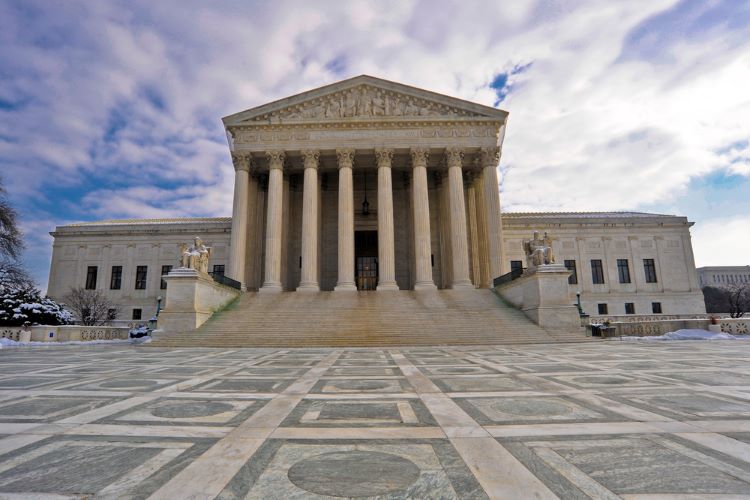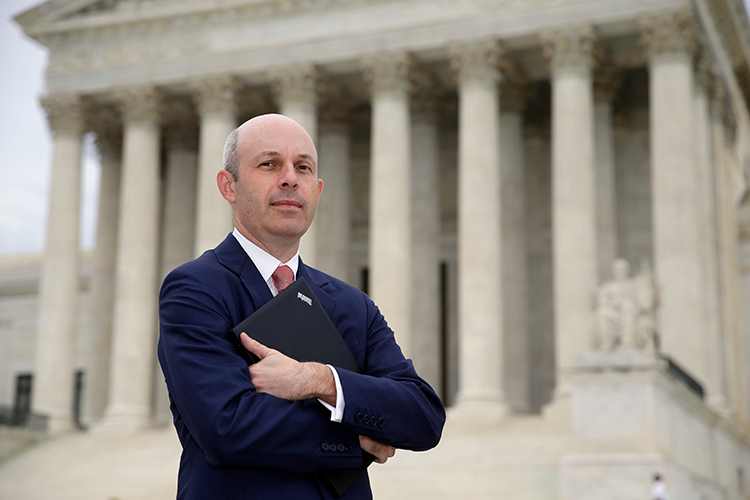Give Us a Break: Supreme Court's summer hiatus interrupted by emergency docket cases

At a recent annual judicial conference, U.S. Supreme Court Justice Elena Kagan addressed the idea of the court’s summer recess, bemoaning a trend of recent years in which the press of emergency actions encroached on the justices’ relaxation. (Image from Shutterstock)
Updated: After a blockbuster and contentious term that spilled over into July, Supreme Court justices were no doubt eager for their summer recess to begin. That’s when they usually leave town for vacations, speaking engagements, overseas teaching assignments or other pursuits. Mostly, it’s a chance for the nine members of the court to get away from each other.
Chief Justice John Roberts headed to Galway, Ireland, in July for a teaching gig on Supreme Court history, as part of a New England Law in Boston program hosted by the University of Galway.
Justice Neil Gorsuch traveled to Porto, Portugal, in mid-July to teach a two-week seminar on the separation of powers for George Mason University’s Antonin Scalia Law School. When he returned, he launched on a whirlwind schedule of press interviews for his latest book, Over Ruled: The Human Toll of Too Much Law. (The book, written with his former law clerk Janie Nitze, was released Aug. 6.)
Justice Ketanji Brown Jackson, meanwhile, was putting the finishing touches on her own book, a memoir titled Lovely One, to be published Sept. 3.
Other justices were keeping their summer plans closer to the vest, perhaps in part because of increased concerns over security in recent years.
In late July, Justice Elena Kagan traveled to Sacramento, California, for the annual judicial conference of the 9th U.S. Circuit Court of Appeals. Kagan is circuit justice for the San Francisco-based court, and she typically provides some of the more revealing remarks of any member of the court at such circuit functions.
Kagan made headlines during her July 25 conversation with two lower-court judges by endorsing the idea of adding more teeth to the Supreme Court’s ethics policy in the form of an enforcement plan.
But in her wide-ranging talk, Kagan also addressed the idea of the court’s summer recess, bemoaning a trend of recent years in which the press of emergency actions encroached on the justices’ relaxation.
“Our summers used to actually be summers,” Kagan said. “It was one of the great things about our calendar is that it was spaced out so that we would have a break before we went back to the hothouse of decision-making. And just the relentless bringing of these emergencies petitions make that not the case anymore.”
Emergency applications include environment, voting and education
Kagan described returning to her hotel room in Sacramento and receiving some urgent communications from her law clerks about matters arising on the court’s emergency docket.
“I have four new clerks now, and the thing about new clerks is they always write you more than you actually want to know,” Kagan said. “And, so my four clerks wrote me about four separate emergencies that are at the court right now, and some of them deserving of a long memo and some, you know, possibly not.”
Kagan didn’t specify the cases for which she had received the memos from her clerks, but among the emergency matters to reach the court this summer have been these:
West Virginia v. Environmental Protection Agency (and multiple related applications)—In these actions multiple states and industry groups ask the court to block an EPA regulation that would limit carbon emissions in coal- and gas-fired power plants beginning in 2030. The Biden administration filed its response on Aug. 19.
Republican National Committee v. Mi Familia Vota—The GOP is asking the high court to stay a lower court injunction blocking an Arizona law that requires documentary proof of citizenship for voter registration and to vote for president.
Biden v. Missouri and Alaska v. Department of Education—In a complicated set of filings, both the Biden administration and several states are asking the court to weigh in on the administration’s SAVE plan to provide income-based student loan relief.
Department of Education v. Louisiana and Cardona v. Tennessee—Nationwide, 26 states have challenged a Biden administration regulation that interprets Title IX of the Education Amendments of 1972, a statute that bars sex discrimination in federally funded schools and colleges, to include sexual orientation and gender identity. Multiple federal courts have blocked the regulation, and the administration sought partial stays from two of the injunctions. Such stays would have allowed provisions of the rule that were unchallenged or were mostly less controversial take effect across the country.
After mulling the administration’s request for nearly four weeks, including disregarding the Aug. 1 effective date of the new regulation, the high court denied the administration’s motions in an unsigned opinion on Aug. 16. Justice Sonia Sotomayor wrote a partial dissent, joined by Kagan, Gorsuch and Jackson, saying she would have allowed the unchallenged provisions of the Title IX regulation to take effect.
Steve Vladeck, a law professor at Georgetown University Law Center who wrote The Shadow Docket, a 2023 book about emergency applications and other matters not on the court’s regular merits docket, says that this summer in particular has shown the strains of a busy tide of emergency filings.
“In marked contrast to what was true as recently as a decade ago, the justices’ summer ‘break’ … now features a steady stream of significant and divisive emergency applications,” Vladeck wrote on his One First site on Substack. “The more that this has become the new normal, the more the justices would do well to meaningfully reflect on whether this shift in their workflow is actually a healthy one (spoiler alert: It isn’t).”
In an interview, Vladeck says that some of the at least 15 still-pending emergency applications (as of Aug. 19) “aren’t truly emergencies.”
“The chief justice gave EPA three weeks to respond to the power plant cases,” he says, which suggests the issues aren’t nearly as urgent as the applicants make them out to be.
The court has procedures in place to handle such matters and allow the justices to weigh in even if they are traveling.
But “the court is not set up to move quickly in August,” Vladeck says.
He criticized the court’s disposition of the Title IX emergency applications as “a huge mess.” The unsigned majority opinion ignored some key arguments raised by U.S. Solicitor General Elizabeth B. Prelogar, he says, and the dissent failed to call out the majority on that and helped leave a “misimpression that the justices have doubts about the substantive merits of the new Title IX rule, when in fact it’s unlikely that they assessed those merits at all.”
Moving cases from emergency docket to the courtroom
Criticisms from Vladeck and others about the court’s shadow docket has prompted defensiveness from some members of the court—but also an apparent change in approach at times.
In an address at the University of Notre Dame law school in 2021, Alito said there has always been an emergency docket but the term shadow docket suggested a “sinister and threatening” picture of “a dangerous cabal is deciding important issues in a novel, secretive, improper way in the middle of the night, hidden from public view.”
But the court did appear to cut back on issued emergency actions late in the evening, and it has moved some emergency matters to its merits docket and scheduled oral arguments.
One major example of that was the Texas case involving Senate Bill 8, a restrictive abortion law that delegated enforcement authority to private individuals. The court had allowed the law to take effect in an emergency action in the summer of 2021, but it also scheduled arguments and issued an opinion that sharply limited the ability of abortion providers to challenge the law in lower courts.
And though it didn’t reach them during the summer, in this past term, the justices acted on their emergency docket in blocking a lower court injunction against an Idaho law that criminalized most abortions in the state. But the justices agreed to hear arguments on whether that state law was in conflict with a federal statute that requires federally funded hospitals to provide essential care to patients with medical emergencies.
By the end of the term in late June, however, the court dismissed the case from its merits docket and dissolved its orders that had allowed the state law to take effect, with four justices writing opinions concurring or dissenting (or both).
(CNN’s Joan Biskupic reported last month on some of the behind-the-scenes drama resulting in the outcome in that case.)
Kagan, in her appearance before the 9th Circuit, suggested the Idaho case had been a bit of an object lesson on how the court handles cases from its emergency docket.
“We realized the case was much too preliminary for us to review,” she said. “And that maybe is a good lesson to us to sort of say, as to some of these emergency petitions, say ‘no, too soon, too early, let the process play out.’”
“So it’s a very difficult question as to how exactly we should approach these ever-increasing number of emergency petitions,” Kagan said.
Updated Aug. 22 at 4:18 p.m. to clarify that Chief Justice John Roberts taught at a New England Law in Boston program hosted by the University of Galway.



